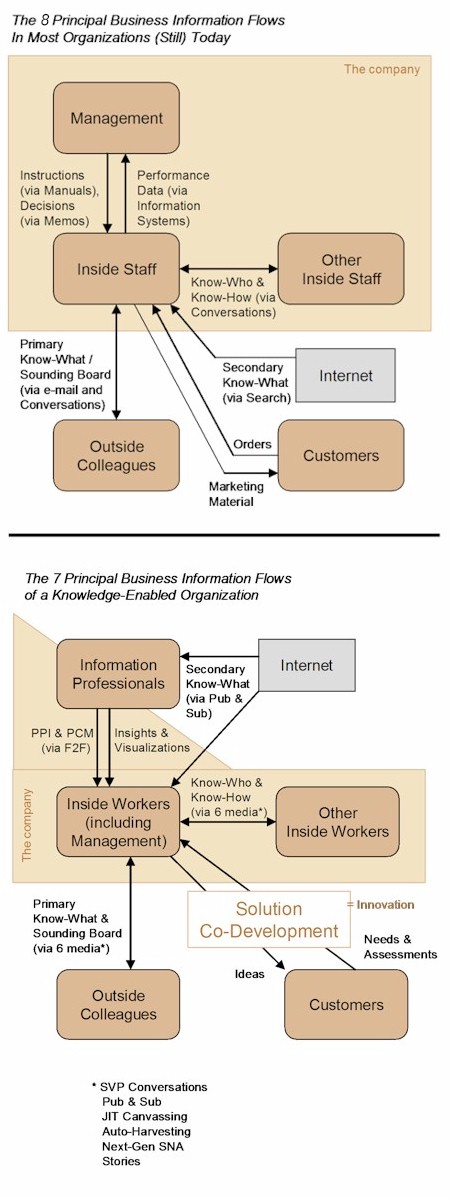 A dozen years after the debut of what has been called ‘Knowledge Management’, there has been little significant change in the efficiency, effectiveness or value of information processes or content in most organizations. Many companies that jumped early onto the KM bandwagon have all but abandoned it, while many organizations that waited are now repeating the same mistakes of the pioneers. Despite this, interest in KM remains substantial, and this is because, while its promise has not really been realized, it is still possible — and enormous. What most organizations essentially did with KM was automate existing information processes. They took the paper ‘stuff’ in manuals and memoranda and newspapers and converted it into digital form. That made it easier and (sometimes) cheaper to maintain, but did not increase its value, which was, if you were to ask most of the people on the front line, pretty marginal anyway. Organizations provided staff with access to the Internet, but most of those who were inclined to use it already had it at home and were using it there, without the restrictions imposed by the company — so that, too, was of marginal benefit. In some cases employees are still forced to shuttle critical information between their work and home PCs. Most organizations, too, refused to abandon the top-down centralized information model that was already in place, merely institutionalizing it with firewalls, access restrictions, monster centrally-managed one-size-fits-all databases and websites and over-engineered, over-managed collaboration and community-of-practice tools. Democratizing corporate information entails the devolution of decision-making and other power to front-line workers, and executives are understandably nervous about this. Essentially, neither managers nor early KM practitioners ‘got it’: KM is all about enabling people to share relevant, context-rich information more freely so that they can be more effective doing their unique jobs. As a result, the critical business information flows, shown in the top diagram above, are essentially unchanged from what they were a decade ago. There have been some minor changes in the technologies used for these flows, but for the most part these have not been significant in improving front-line effectiveness of workers, and in some cases have actually made work more difficult. Management continues to rely on well-entrenched IS to promulgate instructions and policy decisions and to extract, often annoyingly and disruptively, information from the front lines that it needs to make business decisions. To traditional managers, information is all about telling employees what to do and making sure they do it. Customers, outside the corporate firewalls and not inclined to participate in suppliers’ technology initiatives designed for the suppliers’ needs rather than theirs (like most e-newsletters, e-rooms and Extranets), continue to interact, information-wise, with suppliers the way they always have — receive (and usually turf) the marketing mail, put in their orders and rely on their ‘relationship manager’ to decipher the former and process the latter effectively. Business as usual, largely unaffected by KM. Things happen the way they do in organizations for a reason. When people are unable to get the information they need ‘within the system’, they will find workarounds to get it in other ways. This is nothing new, and it is commendable — it shows people care about the quality and effectiveness of their work. The #1 means of getting and sharing information is, was, and probably always will be conversations. Pick up the phone, walk down the hall, use IM (if your company allows it), use Skype (if your company allows it), or, as a last resort, send an e-mail to the people who might know what you need to know. It would make sense that KM would facilitate conversations, but if anything it has tried to obsolesce them — substituting databases that purportedly have the information you used to get from talking with people, more efficiently. Not surprisingly, this has rarely worked. The second diagram above shows what is possible — how valuable information flows could be enabled and facilitated by KM. Step by step, here is what KM practitioners would need to do to realize this possibility: Revamp and upgrade the role of Information Professionals from content managers to personal productivity enablers. Most knowledge workers have figured out how to get the content they need to do their jobs well, without any help from KM. Centralized content management initiatives offer little or no incremental value to them. What they need is hands-on help managing their own content, and using the information and technology at their disposal more effectively in the context of doing their own unique jobs. This does not lend itself, in most organizations, to either classroom or computer-based training — it needs to be face-to-face, anthropological: The IP needs to observe how the worker uses technology and information now, and then advise them how to do so more effectively. And at the same time, the IP needs to help each worker organize their personal content so that they can manage it effectively and find (again) what they need when they need it. We need to get IPs away from their collections and help-desks and out into the field helping workers one-on-one. KM needs to become PKM (personal knowledge management). Reintermediate Information Professions to filter and add more value to external content. One of the initial goals of KM was disintermediation — getting rid of the layers between front-line people and useful information. The problem is, most front-line people are now overwhelmed with the volume of information coming at them, and find most of what is available on the Internet too raw for their needs: They need help making meaning out of this information. IPs, as reintermediaries, can fill this need in two ways: They can massage raw information using visualizations, maps, tableaux, systems thinking charts, single frames, decision trees and other techniques, and they can add insight by synthesizing, analyzing, organizing and providing context this information so that, in the hands of the knowledge worker, it is ready to apply. Develop simple, automated, Pub & Sub mechanisms to encourage and enable workers to ‘publish’ their knowledge and subscribe to that of others, inside and outside the organization. With the advent of blogs, wikis and RSS this has become much easier, and it allows much more context-rich capture of information than centralized database submission processes. Create new media to allow workers to obtain and share ‘know-how’, ‘know-who’ and ‘know-what’ information from colleagues both inside and outside the organization. In addition to the Pub & Sub mechanism described above, promising new media include:
Provide tools and information resources that enable and enhance solution co-development with clients. My previous posts on innovation and on the Wisdom of Crowds provide details on how these resources could be developed and what they might look like. The idea is to facilitate powerful knowledge transfer, collaboration and innovation with customers, using methods to identify and communicate to customers ideas and opportunities, assess current and prospective customers’ unmet needs, and then work with customers to develop solutions that fill these needs effectively. This can’t be done as a KM initiative alone, of course; it requires agreement on the need for a new, closer relationship with customers, and implementation of a comprehensive innovation strategy. But information is absolutely critical to its success. While many savvy small entrepreneurial organizations are adopting many of the above knowledge-enabled business programs, most large organizations aren’t yet prepared to do so. Some of these programs are very threatening to management, since through devolution of useful information they also devolve organizational power. Most of them entail some considerable risk and cost, and until and unless a greater sense of urgency arises for better use of information in organizations and better front-line work effectiveness, managers are unlikely to commit the resources to bring such programs to fruition. The preoccupations of corporate managers these days, when it comes to ‘back-office’ functions like KM, are (1) security and risk minimization, and (2) cost reduction and outsourcing. They will wait for pioneers to show them that the risks and costs of such programs are far outweighed by the benefits of better productivity, more engaged employees, greater innovation, and delighted customers. Until then, most large organizations’ key information flows will continue to be focused on instructions, performance and compliance data, order-taking, promulgation of marketing material and other so-called customer relationship management data. For them, the promise of KM is still, alas, probably many years away. |
Navigation
Collapsniks
Albert Bates (US)
Andrew Nikiforuk (CA)
Brutus (US)
Carolyn Baker (US)*
Catherine Ingram (US)
Chris Hedges (US)
Dahr Jamail (US)
Dean Spillane-Walker (US)*
Derrick Jensen (US)
Dougald & Paul (IE/SE)*
Erik Michaels (US)
Gail Tverberg (US)
Guy McPherson (US)
Honest Sorcerer
Janaia & Robin (US)*
Jem Bendell (UK)
Mari Werner
Michael Dowd (US)*
Nate Hagens (US)
Paul Heft (US)*
Post Carbon Inst. (US)
Resilience (US)
Richard Heinberg (US)
Robert Jensen (US)
Roy Scranton (US)
Sam Mitchell (US)
Tim Morgan (UK)
Tim Watkins (UK)
Umair Haque (UK)
William Rees (CA)
XrayMike (AU)
Radical Non-Duality
Tony Parsons
Jim Newman
Tim Cliss
Andreas Müller
Kenneth Madden
Emerson Lim
Nancy Neithercut
Rosemarijn Roes
Frank McCaughey
Clare Cherikoff
Ere Parek, Izzy Cloke, Zabi AmaniEssential Reading
Archive by Category
My Bio, Contact Info, Signature Posts
About the Author (2023)
My Circles
E-mail me
--- My Best 200 Posts, 2003-22 by category, from newest to oldest ---
Collapse Watch:
Hope — On the Balance of Probabilities
The Caste War for the Dregs
Recuperation, Accommodation, Resilience
How Do We Teach the Critical Skills
Collapse Not Apocalypse
Effective Activism
'Making Sense of the World' Reading List
Notes From the Rising Dark
What is Exponential Decay
Collapse: Slowly Then Suddenly
Slouching Towards Bethlehem
Making Sense of Who We Are
What Would Net-Zero Emissions Look Like?
Post Collapse with Michael Dowd (video)
Why Economic Collapse Will Precede Climate Collapse
Being Adaptable: A Reminder List
A Culture of Fear
What Will It Take?
A Future Without Us
Dean Walker Interview (video)
The Mushroom at the End of the World
What Would It Take To Live Sustainably?
The New Political Map (Poster)
Beyond Belief
Complexity and Collapse
Requiem for a Species
Civilization Disease
What a Desolated Earth Looks Like
If We Had a Better Story...
Giving Up on Environmentalism
The Hard Part is Finding People Who Care
Going Vegan
The Dark & Gathering Sameness of the World
The End of Philosophy
A Short History of Progress
The Boiling Frog
Our Culture / Ourselves:
A CoVid-19 Recap
What It Means to be Human
A Culture Built on Wrong Models
Understanding Conservatives
Our Unique Capacity for Hatred
Not Meant to Govern Each Other
The Humanist Trap
Credulous
Amazing What People Get Used To
My Reluctant Misanthropy
The Dawn of Everything
Species Shame
Why Misinformation Doesn't Work
The Lab-Leak Hypothesis
The Right to Die
CoVid-19: Go for Zero
Pollard's Laws
On Caste
The Process of Self-Organization
The Tragic Spread of Misinformation
A Better Way to Work
The Needs of the Moment
Ask Yourself This
What to Believe Now?
Rogue Primate
Conversation & Silence
The Language of Our Eyes
True Story
May I Ask a Question?
Cultural Acedia: When We Can No Longer Care
Useless Advice
Several Short Sentences About Learning
Why I Don't Want to Hear Your Story
A Harvest of Myths
The Qualities of a Great Story
The Trouble With Stories
A Model of Identity & Community
Not Ready to Do What's Needed
A Culture of Dependence
So What's Next
Ten Things to Do When You're Feeling Hopeless
No Use to the World Broken
Living in Another World
Does Language Restrict What We Can Think?
The Value of Conversation Manifesto Nobody Knows Anything
If I Only Had 37 Days
The Only Life We Know
A Long Way Down
No Noble Savages
Figments of Reality
Too Far Ahead
Learning From Nature
The Rogue Animal
How the World Really Works:
Making Sense of Scents
An Age of Wonder
The Truth About Ukraine
Navigating Complexity
The Supply Chain Problem
The Promise of Dialogue
Too Dumb to Take Care of Ourselves
Extinction Capitalism
Homeless
Republicans Slide Into Fascism
All the Things I Was Wrong About
Several Short Sentences About Sharks
How Change Happens
What's the Best Possible Outcome?
The Perpetual Growth Machine
We Make Zero
How Long We've Been Around (graphic)
If You Wanted to Sabotage the Elections
Collective Intelligence & Complexity
Ten Things I Wish I'd Learned Earlier
The Problem With Systems
Against Hope (Video)
The Admission of Necessary Ignorance
Several Short Sentences About Jellyfish
Loren Eiseley, in Verse
A Synopsis of 'Finding the Sweet Spot'
Learning from Indigenous Cultures
The Gift Economy
The Job of the Media
The Wal-Mart Dilemma
The Illusion of the Separate Self, and Free Will:
No Free Will, No Freedom
The Other Side of 'No Me'
This Body Takes Me For a Walk
The Only One Who Really Knew Me
No Free Will — Fightin' Words
The Paradox of the Self
A Radical Non-Duality FAQ
What We Think We Know
Bark Bark Bark Bark Bark Bark Bark
Healing From Ourselves
The Entanglement Hypothesis
Nothing Needs to Happen
Nothing to Say About This
What I Wanted to Believe
A Continuous Reassemblage of Meaning
No Choice But to Misbehave
What's Apparently Happening
A Different Kind of Animal
Happy Now?
This Creature
Did Early Humans Have Selves?
Nothing On Offer Here
Even Simpler and More Hopeless Than That
Glimpses
How Our Bodies Sense the World
Fragments
What Happens in Vagus
We Have No Choice
Never Comfortable in the Skin of Self
Letting Go of the Story of Me
All There Is, Is This
A Theory of No Mind
Creative Works:
Mindful Wanderings (Reflections) (Archive)
A Prayer to No One
Frogs' Hollow (Short Story)
We Do What We Do (Poem)
Negative Assertions (Poem)
Reminder (Short Story)
A Canadian Sorry (Satire)
Under No Illusions (Short Story)
The Ever-Stranger (Poem)
The Fortune Teller (Short Story)
Non-Duality Dude (Play)
Your Self: An Owner's Manual (Satire)
All the Things I Thought I Knew (Short Story)
On the Shoulders of Giants (Short Story)
Improv (Poem)
Calling the Cage Freedom (Short Story)
Rune (Poem)
Only This (Poem)
The Other Extinction (Short Story)
Invisible (Poem)
Disruption (Short Story)
A Thought-Less Experiment (Poem)
Speaking Grosbeak (Short Story)
The Only Way There (Short Story)
The Wild Man (Short Story)
Flywheel (Short Story)
The Opposite of Presence (Satire)
How to Make Love Last (Poem)
The Horses' Bodies (Poem)
Enough (Lament)
Distracted (Short Story)
Worse, Still (Poem)
Conjurer (Satire)
A Conversation (Short Story)
Farewell to Albion (Poem)
My Other Sites





“…the promise of KM is still, alas, probably many years away.” No, the technology is available now. Please visit http://manyworlds.com ManyWorlds Inc.’s sponsored site demonstating it’s patented Epiture technology and acting as the 2006 Webby Award winning Honree site for THOUGHT LEADERSHIP FOR BUSINESS. More to come.
Hello,After visiting your site, i belive it would be mutually beneficial to exchange links. Not only could we drive more traffic to our sites and get a boost in search engines ranking, but we would be adding value to our respective customer bases as wellwork at home